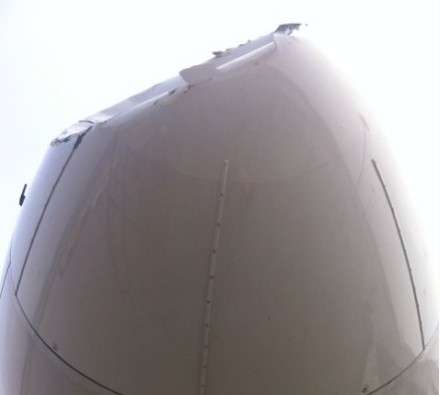It looks like you're using an Ad Blocker.
Please white-list or disable AboveTopSecret.com in your ad-blocking tool.
Thank you.
Some features of ATS will be disabled while you continue to use an ad-blocker.
share:
This is a strange story that was published in some China papers two days ago.
I'll try to translate for you the best way I can what they said about this event:
"The news were broken by the Chinese news agency June 4, 2013 and involved an aircraft operated by Air China, which was hit by an unidentified flying object."

"It all happened on the morning of June 4, 2013, when a Boeing 757 operated by Air China, flying from Chengdu to Guangzhou, at an altitude of 26,000 feet (8,000 meters), was hit by an unknown object.
The incident occurred 20 minutes after takeoff, but caused no injuries among passengers and crew. According to news agencies, the Boeing 757 took off at 10:11 (local time) from Shuangliu Airport in Chengdu and after about 20 minutes of flight, after the problem occurred, the airplane was forced to make an emergency landing at Shuangliu airport.

The pilot of the Boeing 757 informed the control tower that the emergency landing was due to a "mechanical failure," but one of the passengers on the flight, having got off the plane, took pictures of it on the tarmac and they showed something very different than the presumed mechanical failure. The nose of the plane was visibly damaged, as if he had been hit by another aircraft.

The airport authorities have opened an investigation immediately and, very quickly, asserted that they have found the cause of the accident, which was that the aircraft just hit a bird.
Looking at the diameter and type of impact, readers may wonder what kind of bird it was, since the incident occurred 26.000ft above sea level.
Maybe it was a pterodactyl?
Readers can also remind that a similar incident occurred in 2008 in the United States
A bird? At 26.000 ft?
And what "incident" the article refer to that occurred back in 2008 in the USA?
Sources (in Chinese):
- news.jike.com
- cnhuadong.net

I'll try to translate for you the best way I can what they said about this event:
"The news were broken by the Chinese news agency June 4, 2013 and involved an aircraft operated by Air China, which was hit by an unidentified flying object."

"It all happened on the morning of June 4, 2013, when a Boeing 757 operated by Air China, flying from Chengdu to Guangzhou, at an altitude of 26,000 feet (8,000 meters), was hit by an unknown object.
The incident occurred 20 minutes after takeoff, but caused no injuries among passengers and crew. According to news agencies, the Boeing 757 took off at 10:11 (local time) from Shuangliu Airport in Chengdu and after about 20 minutes of flight, after the problem occurred, the airplane was forced to make an emergency landing at Shuangliu airport.

The pilot of the Boeing 757 informed the control tower that the emergency landing was due to a "mechanical failure," but one of the passengers on the flight, having got off the plane, took pictures of it on the tarmac and they showed something very different than the presumed mechanical failure. The nose of the plane was visibly damaged, as if he had been hit by another aircraft.

The airport authorities have opened an investigation immediately and, very quickly, asserted that they have found the cause of the accident, which was that the aircraft just hit a bird.
Looking at the diameter and type of impact, readers may wonder what kind of bird it was, since the incident occurred 26.000ft above sea level.
Maybe it was a pterodactyl?
Readers can also remind that a similar incident occurred in 2008 in the United States
A bird? At 26.000 ft?
And what "incident" the article refer to that occurred back in 2008 in the USA?
Sources (in Chinese):
- news.jike.com
- cnhuadong.net

edit on 6-6-2013 by elevenaugust because: (no reason given)
I'd think there would be carnage if the was a collision in mid air. Probably a hoax and the plane hit something while on the ground.
Perhaps a weather ballon with some small equipment attattched.
Perhaps a weather ballon with some small equipment attattched.
edit on 6-6-2013 by Wifibrains because: (no reason given)
reply to post by elevenaugust
Pilot error on the tarmac. No way that plane landed after a mid-air collision.
Pilot error on the tarmac. No way that plane landed after a mid-air collision.
Does it only take 20 minutes to reach 26,000 ft?
Don't know and can't find it.
Peace
Don't know and can't find it.
Peace
What can the plane hit while rolling on tarmac to create a huge circular crater? The control tower? Another parked plane which bumped it nose to nose?
So if it was a collision on tarmac the object just vanished after the plane hit it?
It is what it is, the plane hit an unidentified flying object while in the air.
So if it was a collision on tarmac the object just vanished after the plane hit it?
It is what it is, the plane hit an unidentified flying object while in the air.
reply to post by elevenaugust
According to this its being reported as a bird strike .
According to this its being reported as a bird strike .
This is a bird strike event, very occasionally Reporter contacted yesterday evening southern base of the China International Aviation and relevant person in charge, according to its understanding that, yesterday morning 10:11, CA4307 Chengdu - Shuangliu Airport in Chengdu, Guangzhou Flights normal take-off in about 20 minutes after takeoff, flight onboard radome was suddenly a bird strike, 'After the accident occurred, the flight captain calmly, in order to consider the life and property safety of passengers in contact with the Chengdu airport, follow the prescribed procedures the plane back to Chengdu.' In 10:59 yesterday morning, the flight successfully returned to the Shuangliu Airport, the passengers unharmed.
www.newshome.us...
reply to post by jude11
Google "Boeing 757 climb rate" and you will see that it could very easily make that altitude in 20 minutes.
Info on bird flight altitude
Here
Google "Boeing 757 climb rate" and you will see that it could very easily make that altitude in 20 minutes.
Info on bird flight altitude
Here
edit on 6-6-2013 by whywhynot because: (no reason given)
It could have been a bird.
www.npwrc.usgs.gov...
Yet birds do fly at higher altitudes. Bird flight at 20,000 feet, where less than half the oxygen is present than at sea level, is impressive if only because the work is achieved by living muscle tissue. A Himalayan mountain climber at 16,000 feet was rather amazed when a flock of geese flew northward about two miles over his head honking as they went. At 20,000 feet a man has a hard time talking while running, but those geese were probably flying at 27,000 feet and even calling while they traveled at this tremendous height. Numerous other observations have come from the Himalayas. Observers at 14,000 feet recorded storks and cranes flying so high that they could be seen only through field glasses. In the same area large vultures were seen soaring at 25,000 feet and an eagle carcass was found at 26,000 feet.
Other accurate records on altitude of migratory flights are scanty, although altimeter observations from airplanes and radar are becoming more frequent in the literature. For example, a Mallard was struck by a commercial airliner at 21,000 feet over the Nevada desert.
www.npwrc.usgs.gov...
Originally posted by elevenaugust
....A bird? At 26.000 ft?
As others have mentioned, there are birds that can fly that high. For example, bar-headed geese regularly migrate a similar altitudes.
Here is an excerpt from a paper written about the ability of some birds to survive the lack of oxygen while flying at high altitudes:
Under conditions of progressive hypoxia, oxygen transport was compared in bar-headed geese (Anser indicus), a species which breeds on the Tibetan Plateau and migrates at altitudes up to 9200 m, and Pekin ducks (Anas platyrhynchos, forma domestica), a similarly sized, sea-level waterfowl that does not fly. Pekin ducks showed no altitude-induced behavioral effects (e.g., restlessness) up to 7620 m, while bar-headed geese tolerated 10,668 m with no observable changes.
Link to source:
Oxygen transport during progressive hypoxia in high-altitude and sea-level waterfowl
Elsewhere I see that the authorities quickly determined that it was not a bird.
There is another thread here BTW.
www.abovetopsecret.com...
There is another thread here BTW.
www.abovetopsecret.com...
edit on 6-6-2013 by smurfy because: Link.
Originally posted by freelance_zenarchist
reply to post by smurfy
Got a map to "elsewhere"?
www.wcarn.com...
I guess that source is derived from Aviation Herald,
avherald.com...
Last post there has yet another theory, that of a static lightning burst, a first hand account. However the account does not detail the damage effect on the radome in relation to this events context, ie; there looks to be scrape marks on the radome.
Originally posted by whywhynot
reply to post by jude11
Google "Boeing 757 climb rate" and you will see that it could very easily make that altitude in 20 minutes.
Info on bird flight altitude
Here
edit on 6-6-2013 by whywhynot because: (no reason given)
Thanks for that.
I Fly a lot but it always feels like a lot longer to reach cruising altitude. Next time, I'll pull out the stop watch.
On second thought, that might get me thrown in a hole somewhere....indefinitely.
Peace
As I said in the other thread, most likely hail. If something solid, like a bird or small UAV as some have speculated had hit, it usually results in
a tear in the skin, and the pilots usually see it before impact. When the USAir flight landed in the Hudson, they saw the geese a good three seconds
before impact, there just wasn't anything they could do. They immediately reported it as a bird strike as well.
I've seen a number of aircraft come home with everything from peeled paint, to dents in the skin from flying through thunderstorms (both with, and without hail). Rain and hail can do a lot of damage to an aircraft at those speeds. And even a large hail stone is not likely to be seen before impact.
I've seen a number of aircraft come home with everything from peeled paint, to dents in the skin from flying through thunderstorms (both with, and without hail). Rain and hail can do a lot of damage to an aircraft at those speeds. And even a large hail stone is not likely to be seen before impact.
edit on 6/6/2013 by Zaphod58 because: (no reason given)
Those darn drunk birds ! Should there be blood? How about alien paint chips? I got it.......
China will claim the secret stealth paint they stole from hacking and visiting the WH was really lifted off a UFO.
China will claim the secret stealth paint they stole from hacking and visiting the WH was really lifted off a UFO.
reply to post by Zaphod58
I would have accepted hail and maybe not thought twice about it, a bird seems rather funny on multiple levels. But hail would of seemed the most logical answer a rather large hail ball like the size of an adults fist at that speed would do some damage like that IMO...
I would have accepted hail and maybe not thought twice about it, a bird seems rather funny on multiple levels. But hail would of seemed the most logical answer a rather large hail ball like the size of an adults fist at that speed would do some damage like that IMO...
Goose Qaeda strikes again...
seriously, who know how high birds fly.
seriously, who know how high birds fly.
reply to post by elevenaugust
The ray dome of aircraft is not very strong, its made of a composite fiber.
If it had hit anything REALLY solid, it would have torn wide open. I agree that this looks like bird-strike to me.
Yes, there are birds that fly over 30K feet, such as the Rüppell's Vulture, one of which was ingested in a jet engine at 36,100 feet on Nov 29, 1973. It's rare, but it does happen.
If it had hit anything REALLY solid, it would have torn wide open. I agree that this looks like bird-strike to me.
Yes, there are birds that fly over 30K feet, such as the Rüppell's Vulture, one of which was ingested in a jet engine at 36,100 feet on Nov 29, 1973. It's rare, but it does happen.
new topics
-
Trump could make a peaceful American Revolution
US Political Madness: 20 minutes ago -
Trump Presidential Transition Team will not use GSA or Government entities to come to DC
US Political Madness: 44 minutes ago -
Mind Blowing Cave under someones land
Fragile Earth: 1 hours ago -
The Party of Peace - Trump Cabinet Picks Targeted with Death Threats
US Political Madness: 2 hours ago -
V.P. Kamala Harris releases a video and nobody understands why
US Political Madness: 5 hours ago -
D.B. Cooper mystery may be solved
General Conspiracies: 9 hours ago
top topics
-
D.B. Cooper mystery may be solved
General Conspiracies: 9 hours ago, 19 flags -
V.P. Kamala Harris releases a video and nobody understands why
US Political Madness: 5 hours ago, 14 flags -
The Party of Peace - Trump Cabinet Picks Targeted with Death Threats
US Political Madness: 2 hours ago, 7 flags -
Mind Blowing Cave under someones land
Fragile Earth: 1 hours ago, 5 flags -
Trump Presidential Transition Team will not use GSA or Government entities to come to DC
US Political Madness: 44 minutes ago, 2 flags -
Trump could make a peaceful American Revolution
US Political Madness: 20 minutes ago, 0 flags
active topics
-
-@TH3WH17ERABB17- -Q- ---TIME TO SHOW THE WORLD--- -Part- --44--
Dissecting Disinformation • 3386 • : Thoughtful3 -
V.P. Kamala Harris releases a video and nobody understands why
US Political Madness • 39 • : chr0naut -
Mind Blowing Cave under someones land
Fragile Earth • 7 • : KrustyKrab -
Petition Calling for General Election at 564,016 and rising Fast
Political Issues • 101 • : gortex -
Trump Presidential Transition Team will not use GSA or Government entities to come to DC
US Political Madness • 1 • : nugget1 -
Trump could make a peaceful American Revolution
US Political Madness • 0 • : stu119 -
The Party of Peace - Trump Cabinet Picks Targeted with Death Threats
US Political Madness • 5 • : chr0naut -
I thought Trump was the existential threat?
World War Three • 102 • : some_stupid_name -
Ed Dowd some good news
Medical Issues & Conspiracies • 40 • : KrustyKrab -
Well, here we go red lines crossed Biden gives the go ahead to use long range missiles
World War Three • 401 • : Xtrozero
